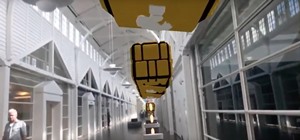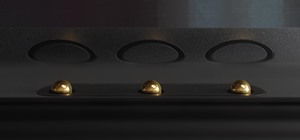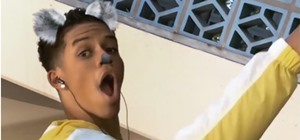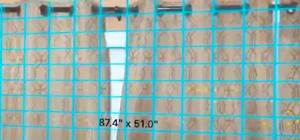For some time now, there has been quite a bit of speculation as to when the selection of augmented and mixed reality head-mounted displays would begin to trickle out to the public. Pricing, availability, and software selection are all issues that will have to be addressed before widespread adoption will start.
Lenovo has already released the first Tango-powered smartphone, the Phab Pro 2, which uses special sensors to give an impressive mobile AR experience. They are also a current Windows Holographic partner, but if we look toward Lenovo's first step into the augmented reality HMD market, we will be waiting awhile for consumer adoption.
The Lenovo New Glass C200 is a fresh take on the monocular-style head-worn AR smartglasses, and would be hard to confuse this unit with Google Glass. The overall sturdy design of the New Glass C200 seems like it belongs on a loading dock, in a warehouse, on the head of an electrician, and in other industrial and commercial areas—not on the head of the average passerby.

The New Glass C200 is powered by a "Pocket Unit" which lets the user, after downloading the new Glass app on their smartphone, use their phone's CPU and LTE connection to enforce the processing of the head unit. It also offers an artificial intelligence named Lenovo NDB Martin to help in the New Glass C200's ability to recognize real-world objects.
Lenovo New Glass C200 recognizes about 20 kinds of objects, such as building schematics within a real-life image and uses AI recognition software, named Lenovo NBD Martin, to identify the image it is viewing and label it using bounding boxes and annotations. Lenovo has created Lenovo NBD Martin to perceive a scene or object through " computer vision," then act as an AI assistant to help identify what the image actually is in real-time. It analyzes data coming from the smart glass camera, sensors and user habit history and combines that insight with user interaction such as voice commands, gestures and pressed buttons to act as an AI assistant, providing commercial users with access to information and tools needed to complete their job.
In addition to the unit and new smartphone software, Lenovo has also developed a new platform called Lenovo NDB Titan. This is a tablet-usable augmented reality content creation system and space viewer that allows multiple users to edit and build spaces seamlessly.

There is currently no pricing or official release information available on this new AR solution, but mass production should start in June of this year. So you can assume that it will be around that time period that they begin to trickle out into the world.
While looking at the overall system they have developed, it seems like this is a well-thought-out project. That said, with all the various moving parts, I am curious if the enterprise customers will bite.
What do you think? Will we soon see monocular systems on our local plumber as he sees the flow of each pipe in the wall?
Just updated your iPhone? You'll find new features for Podcasts, News, Books, and TV, as well as important security improvements and fresh wallpapers. Find out what's new and changed on your iPhone with the iOS 17.5 update.

























Be the First to Comment
Share Your Thoughts